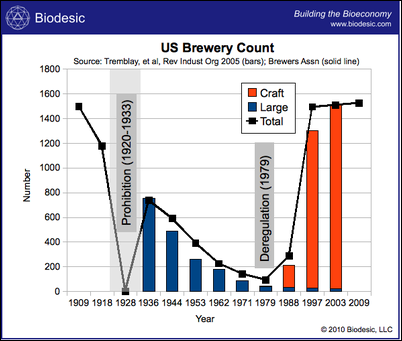Over at The New Republic, there was a small post praising former President Jimmy Carter for saving the beer industry via deregulation:
To make a long story short, prohibition led to the dismantling of many small breweries around the nation. When prohibition was lifted, government tightly regulated the market, and small scale producers were essentially shut out of the beer market altogether. Regulations imposed at the time greatly benefited the large beer makers. In 1979, Carter deregulated the beer industry, opening back up to craft brewers. As the chart below illustrates, this had a really amazing effect on the beer industry:

The increase in breweries over the past few decades is staggering. The industry has reached a milestone with over 2,700 breweries in the U.S. at the end of 2013 with 98% of these being small and independent craft breweries. This is the highest count in close to 140 years. As economist Mark Perry has noted, there has been a 2600% increase in US breweries largely because of craft breweries. Bart Watson, chief economist for the Brewers Association, also finds that “the presence of a strong craft industry has been great for the beer industry.” Between 2009 and 2013, the states with the strongest craft beer industries on average gained volume, while the majority of states lost volume. These craft breweries have also become widely dispersed within the US. While there is still plenty of room for growth, the dispersion is pretty extensive. “Long gone are the days where San Diego and Portland are hogging all the local breweries,” writes Watson. “There are 2,295 [Zip Code Tabulation Areas] that now have a brewery. They range in size from over 100,000 people to 10 (10 ZCTAs with fewer than 100 people have a brewery). Americans, whether they live in urban or rural areas, large towns or small, are increasingly being exposed to beer produced by a local brewer.” Furthermore, this increased competition has led to numerous choices for consumers. As Watson puts it,
Regardless of the optimal number of brands on a shelf, the innovation and entry of so many great new breweries can only be a good thing for the category. Competition breeds innovation, and innovation has bred the incredible diversity of amazing beers available in the US today. The beers that people love will thrive and continue to find shelves and taps and the ones that don’t stand out will fade away. Make a list of your favorite craft beer brands. How many are 10 years old? 5? 1? I know that I’m continuously amazed by the new offerings from America’s 3,000+ breweries, and if it means I have to spend a few extra minutes in the beer aisle sorting out my next selection, it’s worth the wait.[ref]Watson argues against the “choice overload” hypothesis, citing a meta-review that found little evidence to support it.[/ref]
There are a few conclusions I draw from this overview of the beer industry:
1. Regulations often hamper innovation and growth (a major loss for everyone, especially consumers).
2. Perspective is important: information on historical trends is better than snapshot data.
3. There is a difference between pro-business and pro-market.
4. Sometimes I wish Mormons could (still) drink beer.[ref]For a discussion of the changing parameters of the “Word of Wisdom” health code, see historian Thomas G. Alexander’s Dialogue article. See also his Mormonism in Transition: A History of the Latter-day Saints, 1890-1930, 3rd edition (Salt Lake City: Greg Kofford Books, 2012).[/ref]